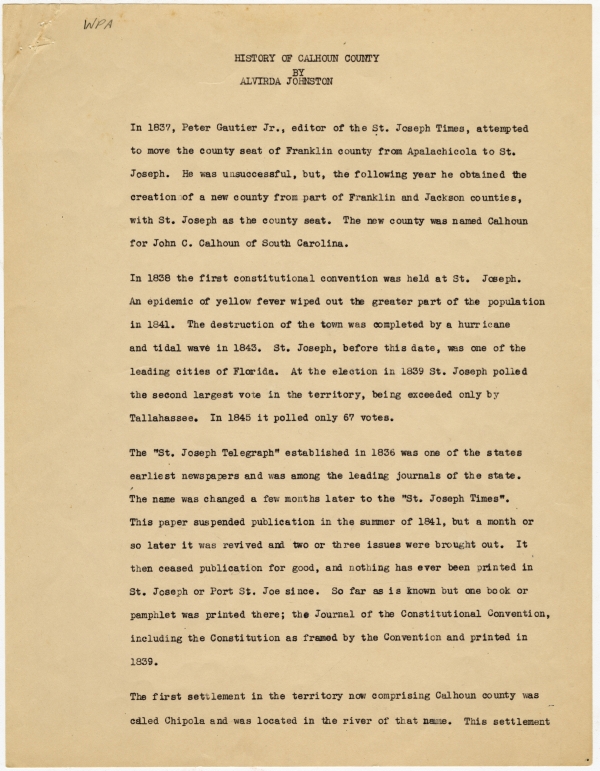WPA
HISTORY OF CALHOUN COUNTY
BY
ALVIRDA JOHNSTON
In 1837, Peter Gautier Jr., editor of the St. Joseph Times, attempted to move the county seat of Franklin county from Apalachicola to St. Joseph. He was unsuccessful, but, the following year he obtained the creation of a new county from part of Franklin and Jackson counties, with St. Joseph as the county seat. The new county was named Calhoun for John C. Calhoun of South Carolina.
In 1838 the first constitutional convention was held at St. Joseph. An epidemic of yellow fever wiped out the greater part of the population in 1841. The destruction of the town was completed by a hurricane and tidal wave in 1843. St. Joseph, before this date, was one of the leading cities of Florida. At the election in 1839 St. Joseph polled the second largest vote in the territory, being exceeded only by Tallahassee. In 1845 it polled only 67 votes.
The "St. Joseph Telegraph" established in 1836 was one of the states [sic] earliest newspapers and was among the leading journals of the state. The name was changed a few months later to the "St. Joseph Times". This paper suspended publication in the summer of 1841, but a month or so later it was revived and two or three issues were brought out. It then ceased publication for good, and nothing has ever been printed in St. Joseph or Port St. Joe since. So far as is known but one book or pamphlet was printed there; the Journal of the Constitutional Convention, including the Constitution as framed by the Convention and printed in 1839.
The first settlement in the territory now comprising Calhoun county was called Chipola and was located in the river of that name. This settlement
Page 2
Calhoun county
was quite important and spread over much of the Northern part of the county. The establishment of Saint Joseph as a political and shipping center, drew from the importance of Chipola, so that the center of population moved from the Northern to the Southern section of the state. After the destruction of Saint Vernon, attention again turned to the Northern section of the county and Abe Springs, on the Chipola river in the center of an agricultural territory became the county seat.
A court house was built at Abe Springs in the 1850's (have not been able to obtain date), but was burned in 1862, destroying most of the county records.
In County Commissioners minutes dated after the fire many references to plans for a new court house. Meanwhile buildings were rented by the county for offices of Clerk of Circuit Court, County Judge, and Sheriff.
Because of a petition signed by 111 voters, on April 1, 1880 a vote was held for removal of the county seat from Abe Springs to Blountstown, about 8 miles east of Abe Springs, on the Apalachicola river. Only 79 of the 308 registered electors voted (all for removal) which ordinarily would have meant that the county seat would have remained where it was, except for a special decision of Judge D. S. Walker, approving the change. The first meeting of County Commissioners held in Blountstown was on May 17, 1880.
In 1882 the Court House was built on a bluff on the Apalachicola river, according to a plan approved in 1878 for a court house in Abe Springs.
Page 3
Calhoun county
The building is still standing and is in good condition. The Court House now in use was built in 1904, and an addition was made in 1914. No damages have occurred to the Court House or records since the removal of the county seat from Abe Springs.
After the creation of Calhoun county, numerous other changes were made in its boundaries. In 1845, part of Jackson was added to Calhoun, while three years later Holmes was formed from Calhoun and Walton. In 1913 Bay was formed from Calhoun and Washington, and in 1925 Calhoun was divided to form Gulf.
Altha, the only other settlement of any size in the county, was incorporated in 1914, but is no longer incorporated.
Today political and industrial activity center around Blountstown. The county is predominately agricultural, though lumbering is still of some importance. The erection of a bridge over the Apalachicola river, connecting Calhoun and Liberty counties, promises to increase the [importance] of this section.
CALHOUN COUNTY BOUNDARY
Starting at a point where the section line between sections twenty three and twenty six, township three, south, range nine west, intersects the Apalachicola river; thence up the middle of the stream of said river to a point where the river intersects the township line between township two, north, and township three, north; thence west along said township line to the middle of the Chipola river; thence down the middle of said river to a point where a line drawn through the center of township two, ranges ten and eleven, west, crosses the said river; thence west on said line through the middle of said township two, range ten, and township two, range eleven, both north and west, to the range line between ranges eleven, and twelve west; thence south along said range line to the southwest corner of section nineteen, range eleven, west, township three, south; thence east to the point of beginning.
FLORIDA WORKS PROGRESS ADMINISTRATION EXCHANGE BUILDING
JACKSONVILLE
Marianna, Florida
March 16, 1937
Mrs. Virginia Maxwell
Edit. Supv., HR & SAS
Jacksonville, Florida
Dear Mrs. Maxwell:
I offer the following information in regard to the formation of Calhoun County.
Calhoun County was created in Jan. 1835, County records were destroyed in a Court House fire of 1862. No reliable information has been obtained about the formation of the first government, though it is said that the first meeting of the County Commissioners took place in St. Joseph in 1838. The first court house was built at Abe Spring, but the date is unknown.
Yours truly,
(S) Alvirda Johnston
Dist. Supv. HR & SAS
aj-ac




 Listen: The Latin Program
Listen: The Latin Program


